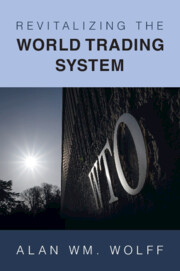Book contents
- Revitalizing the World Trading System
- Revitalizing the World Trading System
- Copyright page
- Dedication
- Contents
- Foreword
- Acknowledgments
- Abbreviations
- Introduction
- Part I Why Trade?
- Part II The Multilateral Trading System
- Part III The Regular Operations of the WTO
- Part IV Major Substantive Topics
- Part V World Trade Governance and Systemic Reform
- Part VI Conclusion
- Afterword
- Select Bibliography
- Index
Introduction
Saving the World Trading System
Published online by Cambridge University Press: 22 June 2023
- Revitalizing the World Trading System
- Revitalizing the World Trading System
- Copyright page
- Dedication
- Contents
- Foreword
- Acknowledgments
- Abbreviations
- Introduction
- Part I Why Trade?
- Part II The Multilateral Trading System
- Part III The Regular Operations of the WTO
- Part IV Major Substantive Topics
- Part V World Trade Governance and Systemic Reform
- Part VI Conclusion
- Afterword
- Select Bibliography
- Index
Summary
This book is designed as a guidebook to the multilateral trading system, its past, its present, and a look toward its potential future. It includes taking the reader on a virtual walk through the corridors of the WTO, the Italianate Centre William Rappard, after hearing of the history of trade and trade negotiations, to sit in on some of the working sessions of delegates. The book’s objective is to convey an understanding of the value of the WTO, as well as the values that it promotes, to have a first-hand feel for what the WTO is all about, to understand its importance and its shortcomings, and to join with it in celebrating its successes. The look to the future includes in these pages some ideas upon which to start a discussion of how to obtain the oft-pledged “WTO reform.”
Keywords
- Type
- Chapter
- Information
- Revitalizing the World Trading System , pp. 1 - 6Publisher: Cambridge University PressPrint publication year: 2023



